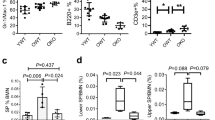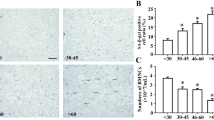Abstract
Chronic myeloid leukemia (CML) is an age-dependent blood malignancy. Like many other age-dependent human diseases, laboratory animal research of CML uses young mice that do not factor in the influence of aging. To understand how aging may impact animal modeling of human age-dependent diseases, we established the first aging mouse model of human CML in BALB/c mice in the advanced age defined by 75% survival. This model was developed by noncytotoxic depletion of bone marrow lineage-positive cells followed by BCR-ABL retroviral transduction and transplantation. CML developed in aging mice shared many similarities to that in young mice, but had increased incidence of anemia that is often seen in human CML. Importantly, we showed that aging of both donor hematopoietic stem cells and recipient bone marrow niche impacted BCR-ABL mediated leukemogenesis and leukemia spectrum. Optimal CML induction relied on age-matching for donors and recipients, and cross-transplantation between young and old mice produced a mixture of different leukemia. Therefore, our model provides initial evidence of the feasibility and merit of CML modeling in aging mice and offers a new tool for future studies of CML stem cell drug resistance and therapeutic intervention in which aging would be taken into consideration as an influencing factor.
This is a preview of subscription content, access via your institution
Access options
Subscribe to this journal
Receive 50 print issues and online access
$259.00 per year
only $5.18 per issue
Buy this article
- Purchase on Springer Link
- Instant access to full article PDF
Prices may be subject to local taxes which are calculated during checkout





Similar content being viewed by others
References
Deininger MW, Druker BJ. Specific targeted therapy of chronic myelogenous leukemia with imatinib. Pharm Rev. 2003;55:401–23.
Hehlmann R, Hochhaus A, Baccarani M, European L. Chronic myeloid leukaemia. Lancet. 2007;370:342–50. https://doi.org/10.1016/S0140-6736(07)61165-9.
Nowell PC. Discovery of the Philadelphia chromosome: a personal perspective. J Clin Invest. 2007;117:2033–5. https://doi.org/10.1172/JCI31771.
Rowley JD. Letter: a new consistent chromosomal abnormality in chronic myelogenous leukaemia identified by quinacrine fluorescence and Giemsa staining. Nature. 1973;243:290–3.
Rowley JD. Ph1-positive leukaemia, including chronic myelogenous leukaemia. Clin Haematol. 1980;9:55–86.
Groffen J, Stephenson JR, Heisterkamp N, de Klein A, Bartram CR, Grosveld G. Philadelphia chromosomal breakpoints are clustered within a limited region, bcr, on chromosome 22. Cell. 1984;36:93–9.
Daley GQ, Van Etten RA, Baltimore D. Induction of chronic myelogenous leukemia in mice by the P210bcr/abl gene of the Philadelphia chromosome. Science. 1990;247:824–30.
Kelliher MA, McLaughlin J, Witte ON, Rosenberg N. Induction of a chronic myelogenous leukemia-like syndrome in mice with v-abl and BCR/ABL. Proc Natl Acad Sci U.S.A. 1990;87:6649–53.
Elefanty AG, Hariharan IK, Cory S. bcr-abl, the hallmark of chronic myeloid leukaemia in man, induces multiple haemopoietic neoplasms in mice. EMBO J. 1990;9:1069–78.
Gishizky ML, Johnson-White J, Witte ON. Efficient transplantation of BCR-ABL-induced chronic myelogenous leukemia-like syndrome in mice. Proc Natl Acad Sci U.S.A. 1993;90:3755–9.
Jordan CT, Guzman ML, Noble M. Cancer stem cells. N. Engl J Med. 2006;355:1253–61. https://doi.org/10.1056/NEJMra061808. e-pub ahead of print 2006/09/23.
Melo JV, Barnes DJ. Chronic myeloid leukaemia as a model of disease evolution in human cancer. Nat Rev Cancer. 2007;7:441–53.
Wang JC, Dick JE. Cancer stem cells: lessons from leukemia. Trends Cell Biol. 2005;15:494–501. https://doi.org/10.1016/j.tcb.2005.07.004.
Wang X, Huang S, Chen JL. Understanding of leukemic stem cells and their clinical implications. Mol Cancer. 2017;16:2 https://doi.org/10.1186/s12943-016-0574-7.
Druker BJ, Guilhot F, O’Brien SG, Gathmann I, Kantarjian H, Gattermann N, et al. Five-year follow-up of patients receiving imatinib for chronic myeloid leukemia. N. Engl J Med. 2006;355:2408–17.
Pophali PA, Patnaik MM. The role of new tyrosine kinase inhibitors in chronic myeloid leukemia. Cancer J. 2016;22:40–50. https://doi.org/10.1097/PPO.0000000000000165.
Hao T, Li-Talley M, Buck A, Chen WY. An emerging trend of rapid increase of leukemia but not all cancers in the aging population in the United States. Sci Rep. 2019;9:12070. https://doi.org/10.1038/s41598-019-48445-1.
Bhatia R, Holtz M, Niu N, Gray R, Snyder DS, Sawyers CL, et al. Persistence of malignant hematopoietic progenitors in chronic myelogenous leukemia patients in complete cytogenetic remission following imatinib mesylate treatment. Blood. 2003;101:4701–7.
Graham SM, Jorgensen HG, Allan E, Pearson C, Alcorn MJ, Richmond L, et al. Primitive, quiescent, Philadelphia-positive stem cells from patients with chronic myeloid leukemia are insensitive to STI571 in vitro. Blood. 2002;99:319–25.
Holtz MS, Slovak ML, Zhang F, Sawyers CL, Forman SJ, Bhatia R. Imatinib mesylate (STI571) inhibits growth of primitive malignant progenitors in chronic myelogenous leukemia through reversal of abnormally increased proliferation. Blood. 2002;99:3792–800.
Chomel JC, Bonnet ML, Sorel N, Bertrand A, Meunier MC, Fichelson S, et al. Leukemic stem cell persistence in chronic myeloid leukemia patients with sustained undetectable molecular residual disease. Blood. 2011;118:3657–60. https://doi.org/10.1182/blood-2011-02-335497.
Pear WS, Miller JP, Xu L, Pui JC, Soffer B, Quackenbush RC, et al. Efficient and rapid induction of a chronic myelogenous leukemia-like myeloproliferative disease in mice receiving P210 bcr/abl-transduced bone marrow. Blood. 1998;92:3780–92.
Zhang X, Ren R. Bcr-Abl efficiently induces a myeloproliferative disease and production of excess interleukin-3 and granulocyte-macrophage colony-stimulating factor in mice: a novel model for chronic myelogenous leukemia. Blood. 1998;92:3829–40.
Li S, Ilaria RL Jr, Million RP, Daley GQ, Van Etten RA. The P190, P210, and P230 forms of the BCR/ABL oncogene induce a similar chronic myeloid leukemia-like syndrome in mice but have different lymphoid leukemogenic activity. J Exp Med. 1999;189:1399–412.
Dash AB, Williams IR, Kutok JL, Tomasson MH, Anastasiadou E, Lindahl K. et al. A murine model of CML blast crisis induced by cooperation between BCR/ABL and NUP98/HOXA9. Proc Natl Acad Sci U.S.A. 2002;99:7622–7. https://doi.org/10.1073/pnas.102583199. e-pub ahead of print 2002/05/29.
Ye D, Wolff N, Li L, Zhang S, Ilaria RL Jr. STAT5 signaling is required for the efficient induction and maintenance of CML in mice. Blood. 2006;107:4917–25.
Yuan H, Wang Z, Li L, Zhang H, Modi H, Horne D. et al. Activation of stress response gene SIRT1 by BCR-ABL promotes leukemogenesis. Blood. 2012;119:1904–14. https://doi.org/10.1182/blood-2011-06-361691. e-pub ahead of print 2011/12/31; blood-2011-06-361691[pii].
Wolff NC, Ilaria RL Jr. Establishment of a murine model for therapy-treated chronic myelogenous leukemia using the tyrosine kinase inhibitor STI571. Blood. 2001;98:2808–16.
Wolff NC, Veach DR, Tong WP, Bornmann WG, Clarkson B, Ilaria RL Jr. PD166326, a novel tyrosine kinase inhibitor, has greater antileukemic activity than imatinib mesylate in a murine model of chronic myeloid leukemia. Blood. 2005;105:3995–4003. https://doi.org/10.1182/blood-2004-09-3534.
Wendel HG, de Stanchina E, Cepero E, Ray S, Emig M, Fridman JS, et al. Loss of p53 impedes the antileukemic response to BCR-ABL inhibition. Proc Natl Acad Sci U.S.A. 2006;103:7444–9. https://doi.org/10.1073/pnas.0602402103.
Hu Y, Swerdlow S, Duffy TM, Weinmann R, Lee FY, Li S. Targeting multiple kinase pathways in leukemic progenitors and stem cells is essential for improved treatment of Ph+ leukemia in mice. Proc Natl Acad Sci U.S.A. 2006;103:16870–5.
Walz C, Ahmed W, Lazarides K, Betancur M, Patel N, Hennighausen L, et al. Essential role for Stat5a/b in myeloproliferative neoplasms induced by BCR-ABL1 and JAK2(V617F) in mice. Blood. 2012;119:3550–60. https://doi.org/10.1182/blood-2011-12-397554.
Hsieh MY, Van Etten RA. IKK-dependent activation of NF-kappaB contributes to myeloid and lymphoid leukemogenesis by BCR-ABL1. Blood. 2014;123:2401–11. https://doi.org/10.1182/blood-2014-01-547943.
Yuan R, Tsaih SW, Petkova SB, Marin de Evsikova C, Xing S, Marion MA, et al. Aging in inbred strains of mice: study design and interim report on median lifespans and circulating IGF1 levels. Aging Cell. 2009;8:277–87. https://doi.org/10.1111/j.1474-9726.2009.00478.x.
Brayton C. Chapter 25 — Spontaneous Diseases in Commonly Used Mouse Strains. In: Fox JG, Davisson MT, Quimby FW, Barthold SW, Newcomer CE, Smith AL, editors. The Mouse in Biomedical Research. 2nd ed. Burlington: Academic Press; 2007. p. 623–717.
Longley DB, Harkin DP, Johnston PG. 5-fluorouracil: mechanisms of action and clinical strategies. Nat Rev Cancer. 2003;3:330–8. https://doi.org/10.1038/nrc1074.
Morrison SJ, Wandycz AM, Akashi K, Globerson A, Weissman IL. The aging of hematopoietic stem cells. Nat Med. 1996;2:1011–6.
Koptyra M, Falinski R, Nowicki MO, Stoklosa T, Majsterek I, Nieborowska-Skorska M, et al. BCR/ABL kinase induces self-mutagenesis via reactive oxygen species to encode imatinib resistance. Blood. 2006;108:319–27.
Wang Z, Chen CC, Chen WY. CD150- side population defines leukemia stem cells in a BALB/c mouse model of CML and is depleted by genetic loss of SIRT1. Stem Cells. 2015;33:3437–51. https://doi.org/10.1002/stem.2218.
Van Etten RA. Studying the pathogenesis of BCR-ABL+ leukemia in mice. Oncogene. 2002;21:8643–51. https://doi.org/10.1038/sj.onc.1206091.
de Haan G, Lazare SS. Aging of hematopoietic stem cells. Blood. 2018;131:479–87. https://doi.org/10.1182/blood-2017-06-746412.
Ho YH, Mendez-Ferrer S. Microenvironmental contributions to hematopoietic stem cell aging. Haematologica. 2020;105:38–46. https://doi.org/10.3324/haematol.2018.211334.
Ko PS, Yu YB, Liu YC, Wu YT, Hung MH, Gau JP, et al. Moderate anemia at diagnosis is an independent prognostic marker of the EUTOS, Sokal, and Hasford scores for survival and treatment response in chronic-phase, chronic myeloid leukemia patients with frontline imatinib. Curr Med Res Opin. 2017;33:1737–44. https://doi.org/10.1080/03007995.2017.1356708.
Liu Z, Shi Y, Yan Z, He Z, Ding B, Tao S, et al. Impact of anemia on the outcomes of chronic phase chronic myeloid leukemia in TKI era. Hematology. 2020;25:181–5. https://doi.org/10.1080/16078454.2020.1765563.
Moura MS, Benevides TCL, Delamain MT, Duarte GO, Percout PO, Dias MA, et al. Evaluation of anemia after long-term treatment with imatinib in chronic myeloid leukemia patients in chronic phase. Hematol Transfus Cell Ther. 2019;41:329–34. https://doi.org/10.1016/j.htct.2019.03.006.
Oyekunle AA, Durosinmi MA, Bolarinwa RA, Owojuyigbe T, Salawu L, Akinola NO. Chronic myeloid leukemia in nigerian patients: anemia is an independent predictor of overall survival. Clin Med Insights: Blood Disord. 2016;9:9–13.
Hamamyh T, Yassin MA. Autoimmune hemolytic anemia in chronic myeloid leukemia. Pharmacology. 2020: 1–9. https://doi.org/10.1159/000507295.
Duarte D, Hawkins ED, Lo Celso C. The interplay of leukemia cells and the bone marrow microenvironment. Blood. 2018;131:1507–11. https://doi.org/10.1182/blood-2017-12-784132.
Perrotti D, Jamieson C, Goldman J, Skorski T. Chronic myeloid leukemia: mechanisms of blastic transformation. J Clin Invest. 2010;120:2254–64.
Wolach O, Stone RM. How I treat mixed-phenotype acute leukemia. Blood. 2015;125:2477–85. https://doi.org/10.1182/blood-2014-10-551465.
Alexander TB, Gu Z, Iacobucci I, Dickerson K, Choi JK, Xu B, et al. The genetic basis and cell of origin of mixed phenotype acute leukaemia. Nature. 2018;562:373–9. https://doi.org/10.1038/s41586-018-0436-0.
Butcher SK, Chahal H, Nayak L, Sinclair A, Henriquez NV, Sapey E, et al. Senescence in innate immune responses: reduced neutrophil phagocytic capacity and CD16 expression in elderly humans. J Leukoc Biol. 2001;70:881–6.
Brubaker AL, Rendon JL, Ramirez L, Choudhry MA, Kovacs EJ. Reduced neutrophil chemotaxis and infiltration contributes to delayed resolution of cutaneous wound infection with advanced age. J Immunol. 2013;190:1746–57. https://doi.org/10.4049/jimmunol.1201213.
Florian MC, Dorr K, Niebel A, Daria D, Schrezenmeier H, Rojewski M. et al. Cdc42 activity regulates hematopoietic stem cell aging and rejuvenation. Cell Stem Cell. 2012;10:520–30. https://doi.org/10.1016/j.stem.2012.04.007. e-pub ahead of print 2012/05/09; S1934-5909(12)00172-5 [ipi].
Helbling PM, Pineiro-Yanez E, Gerosa R, Boettcher S, Al-Shahrour F, Manz MG. et al. Global transcriptomic profiling of the bone marrow stromal microenvironment during postnatal development, aging, and inflammation. Cell Rep. 2019;29:3313–30. https://doi.org/10.1016/j.celrep.2019.11.004. e3314.
Dell RB, Holleran S, Ramakrishnan R. Sample size determination. ILAR J. 2002;43:207–13.
Acknowledgements
This work was supported by the grants UH2/3 CA213385 (co-sponsored by NIH National Cancer Institute and National Institute of Aging) and 3UH3CA213385-05S1 (sponsored by NIH Office of the Director), as well as institutional grants from the City of Hope Center for Cancer and Aging, and Norton Basic Research Fund to WYC. Research reported in this publication included work performed in the Animal Resources Center and Flow Cytometry Core supported by the National Cancer Institute under the award P30CA33572. The content is solely the responsibility of the authors and do not necessarily represent the official views of the NIH.
Author information
Authors and Affiliations
Corresponding author
Ethics declarations
Conflict of interest
The authors declare no competing interests.
Additional information
Publisher’s note Springer Nature remains neutral with regard to jurisdictional claims in published maps and institutional affiliations.
Supplementary information
Rights and permissions
About this article
Cite this article
Hao, T., Zhang, C., Wang, Z. et al. An aging mouse model of human chronic myeloid leukemia. Oncogene 40, 3152–3163 (2021). https://doi.org/10.1038/s41388-021-01770-0
Received:
Revised:
Accepted:
Published:
Issue Date:
DOI: https://doi.org/10.1038/s41388-021-01770-0
This article is cited by
-
The stem cell-specific long non-coding RNAs in leukemia
Clinical and Translational Oncology (2022)



